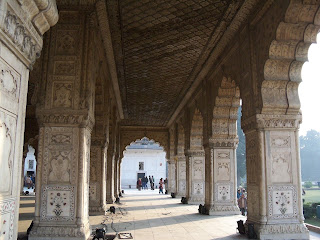 |
North-India is in winter a beauty to behold, we have mornings thickly laden with nebulous layers of fog and mid-afternoons and afternoons when the fulgent sun targets its mollified rays at the heart of the city thus radiating warmth and wintry torpor. It is also a time to travel. The citizens enjoy this period of appricity by discovering the great city and its environs.
 |
| A Foggy Morning |
This Christmas my husband and I had originally planned to celebrate the day by going to the St. James Church, one of the oldest churches in Delhi. However when we arrived at its premises, we found the church closed for the day and decided to visit the Red Fort, a monument I had long wanted to see.
 |
| Red Fort |
Built in the jorum of the Mughal Empire by the emperor Shah Jahan, this seventeenth century fort stands majestically is the pedestrian neighborhood of Chandni Chowk in Old Delhi. Against the backdrop of the watchet sky this Brobdinagian monument stands stolidly as a witness of the changing currents of time. It was from this virtuous place that the first Prime Minister of India, Pandit Jawharlal Nehru, delivered the famous speech "Tryst with destiny" at the stroke of midnight hour when India achieved its freedom on 15 Aug 1947. Every year on the day of independence the National Flag of India is hoisted at the Red Fort by the Prime Minister. As you reach the premises you would observe the red façade of the building with the tri-colored banner waving atop.
Made out or red sandstone this fortress is known for its grand architecture. The main entrance opens on to the Chatta Chowk, a covered street flanked with arched cells that used to house Delhi's most talented jewelers, carpet makers, weavers and goldsmiths. It now houses shops where you can find assorted collections of Indian handicrafts made of wood and brass and other materials(I go myself a couple of Rajasthani puppet dolls from here). As you walk down this dark, strepitous alley you will feel transported to another era, a bygone era whose relics lie before you. The curious eyes of travelers hovering over the two tiers (the second floor is officially closed) of this market suggest awe and inquisitiveness as to what lies beyond this narrow settlement.
 |
| The bazaar |
The Chhattar bazaar leads to a large open space where it crosses the large north-south street that was originally the division between the fort's military functions, to its west, and the palaces, to its east. Representatives of the Indian army stand guard at various points at this juncture. My grandfather who was a colonel in the Indian army narrated stories of the Red Fort and as I saw the tenement I recalled some of them.Beyond the Chatta Chowk is the heart of the fort called Naubat Khana or the Drum House. The musicians used to play for the emperor from the Naubat Khana and the arrival of princes and royalty was heralded from here.
 |
The Diwan-i-Aam |
The Diwan-i-Aam
The Diwan-i-Aam, which is the large pavilion for public imperial audiences, has an ornate throne-balcony (jharokha) for the emperor. The columns were painted in gold and there was a gold and silver railing separating the throne from the public. The cool white marble get-up that now stand frozen in time exude rich regal airs. A net is now drawn across the marble balcony separating the curious onlookers from the royal seat. Old glyptic ceilings hang surreptitiously from above; their intricate designs once studded with precious stones now lay bare like toothless old men showing their gums. The once stelliferous halls are now illuminated by humble halogens and natural light.
 |
The Diwan-i-Khas |
 |
The Diwan-i-Khas |
After you cross the hall of public audience you take a ramp down to an open courtyard richly platted with trees and other important buildings. The Diwan-i-Khas or “hall of private audience” is the first important building you will observe. In Urdu “khas” means special, and this hall was a special chamber used by the king when talking to his special guests. The room with openings of engrailed arches on its sides consists of a rectangular central chamber surrounded by aisles of arches rising from piers. The lower parts of the piers are inlaid with floral designs, while the upper portions are gilded and painted. Over the marble pedestal in its center stood the famous almost-mythical Peacock Throne which was removed in 1739 by Nadir Shah of Persia. It is said that the pavonine throne was an exquisite piece of Persian artifact curved in gold and studded with priceless gems and stones.
As you walk around the Diwan-i-Khas you can let your imagination conjure up from the tessellating pieces of history the golden Peacock Throne housed in the middle of the Diwan-i-Khas. The pillars impleached with majestic Mughal designs done in perfect symmetry will surely add their wonder touches to your imagination. One motif that particularly caught my attention was that of the scales of justice done in marble suspended over a crescent amidst stars and clouds in the northern screen of the Tasbih-Khana ('chamber for counting beads for private prayers').
 |
| Scales of Justice |
Through the center of the Diwan-i-Khas flowed the Nahr-i-Bihisht or the stream of ‘pairidaeza’. The whole get up is paradisal indeed and my view was reiterated by Amir Khusrow the famous 13th century Sufi poet whose verse “if there be a paradise on the earth, it is this, it is this, it is this” is inscribed in one of the walls of the tenement
.
The two southernmost pavilions of the fortress are zenanas, or women's quarters: the Mumtaz Mahal, and the larger, lavish Rang Mahal, which has been famous for its gilded, decorated ceiling and marble pool, fed by the “stream of paradise.” Of the two the Mumtaz Mahal has indeed experienced a transmogrification. Once a seraglio it acted as a prison in 1857 and now it is a museum housing treasures from the Mughal era: daggers and swords and armors, paintings and priceless texts handwritten in exquisite calligraphy, dresses (which will make you smile upon judging the average size of a Mughal emperor), potteries, carpets, traditional rugs and many more. My favorite among the displayed was an embroidered palanquin cover, now almost frayed and dirty yet still retaining some of the old design that some unknown hand or hands stitched on its surface.
 |
| Mumtaz Mahal Museum (this picture is from the web) |
As you walk around the open courtyard imbibing the priceless regal beauties stationed at arms-length you might, if you were a person with a strong linking for the artistic, take issues with the British administrative buildings built behind the garden which are now used by the military. These box-like buildings with their European modernistic façade seem anachronistic in the setting. Perhaps the builders were daunted by the finery of the Mughal art that they build themselves box-palaces just beyond its premises or they were so fond of the royal surroundings that they built their own tenements close to the artistic hearth so as to enjoy the beauty of the Royal fort all day long. Whatever the reason, the sanitarium like buildings will make you twitch your nose.
 |
| British Administrative Building |
Our tour around this ancient monument was over by 5:30 pm. Upon its completion we took a rickshaw (the hand-pulled ones are a relic :-)) and headed to the Chandni Chowk metro station, which is only a few kilometers from the Red Fort. The ride down the Chandni Chowk market bustling with activity, the smell of street foods, and the sight of sweets dipped in sugary syrup condensed the touristy feeling I had been experiencing throughout the day.
At home that night I cooked my Christmas meal: Roasted chicken with vegetables, mashed potatoes and gravy, homemade bread and fruitcake. As I did the dishes I couldn’t help but smile at the wonderful medley of experiences— Christmas meal, Mughal architecture, smell of Indian street food and Metrorail ride—which lay imbricated in my system. A Christmas well spent, is how I concluded my observations for the nox.



































